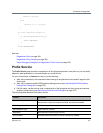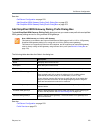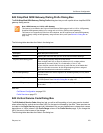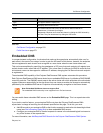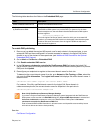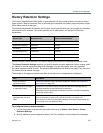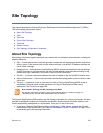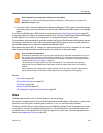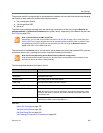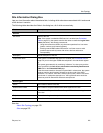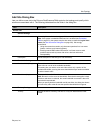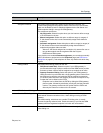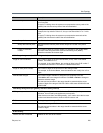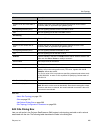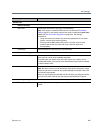
Site Topology
Polycom, Inc. 279
● If you don’t have a Polycom RealPresence Resource Manager or CMA system, enter site topology
information about your network directly into the Polycom RealPresence DMA system’s site topology
pages.
If your Polycom RealPresence DMA system is superclustered (see About Superclustering on page 226),
site topology data only needs to be created (or obtained from a Polycom RealPresence Resource Manager
or CMA system) on one cluster of the supercluster. It’s replicated across the supercluster.
For a conference with cascading for bandwidth enabled, the Polycom RealPresence DMA system uses the
site topology information to route calls to the nearest eligible MCU (based on pools and pool orders) that
has available capacity and to create the cascade links between MCUs.
When determining which MCU is “nearest” to a caller and which path is best for a cascade link, the system
takes into account the bandwidth availability and bit-rate limitations of alternative paths.
See also:
Site Links on page 291
Site-to-Site Exclusions on page 293
Territories on page 294
Network Clouds on page 297
Site Topology Configuration Procedures on page 299
Sites
The Sites page contains a list of the sites defined in the site topology.
If the system is integrated with a Polycom RealPresence Resource Manager or CMA system, it receives this
information from that system, and this page is read-only. If not, you can enter site information.
The default Internet/VPN entry always exists and can’t be edited or deleted. It can’t be assigned to a territory
or controlled by a cluster. Endpoints whose subnet isn’t in any defined site in the enterprise network are
considered to be in the Internet/VPN site. They can register to a cluster only if site-less registrations are
allowed (see Registration Policy on page 264).
Note: Integration Not Supported in Maximum Security Mode
Integration with a Polycom RealPresence Resource Manager or CMA system is not supported in
Maximum security mode.
Note: Cascade Considerations
Cascading for bandwidth uses a hub-and-spoke configuration so that each cascaded MCU is only one
link away from the “hub” MCU, which hosts the conference. The conference is hosted on the same
MCU that would have been chosen in the absence of cascading, using the pool order applicable to the
conference. See MCU Pool Orders on page 145.
The cascade links between MCUs must use H.323 signaling. For conferences with cascading
enabled, the Polycom RealPresence DMA system selects only MCUs that have H.323 signaling
enabled.
This cascade link requirement doesn’t affect endpoints, which may dial in using SIP (assuming the
MCUs and the Polycom RealPresence DMA system are also configured for SIP signaling).



